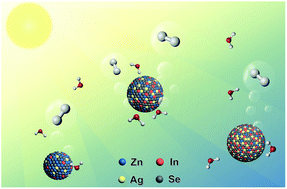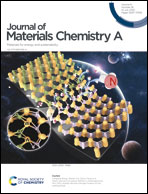Controlling the visible-light driven photocatalytic activity of alloyed ZnSe–AgInSe2 quantum dots for hydrogen production†
Abstract
Binary semiconductor quantum dots such as CdS and CdSe have been widely studied as photocatalysts for hydrogen production, but the high toxicity of Cd impedes their widespread deployment. Recently, multinary I–III–VI-based semiconductors, e.g., AgInS2 and CuInS2, have emerged as promising alternatives for environmentally benign photocatalysts. In this work, we prepared quantum dots (QDs) composed of an alloyed ZnSe–AgInSe2 (ZAISe) semiconductor and evaluated their photocatalytic activity for hydrogen (H2) production. By individually controlling the fractions of Zn and Ag, that is, the ratios of (Ag + In)/(Zn + Ag + In) and Ag/(Ag + In), the band structure of ZAISe QDs could be finely tuned to improve their photocatalytic activity. The action spectra of the photocatalytic reaction of ZAISe QDs revealed vigorous activity across the whole visible region from 400 to 700 nm. The highest apparent quantum yield of H2 production reached 3.4% under irradiation at 600 nm.



 Please wait while we load your content...
Please wait while we load your content...